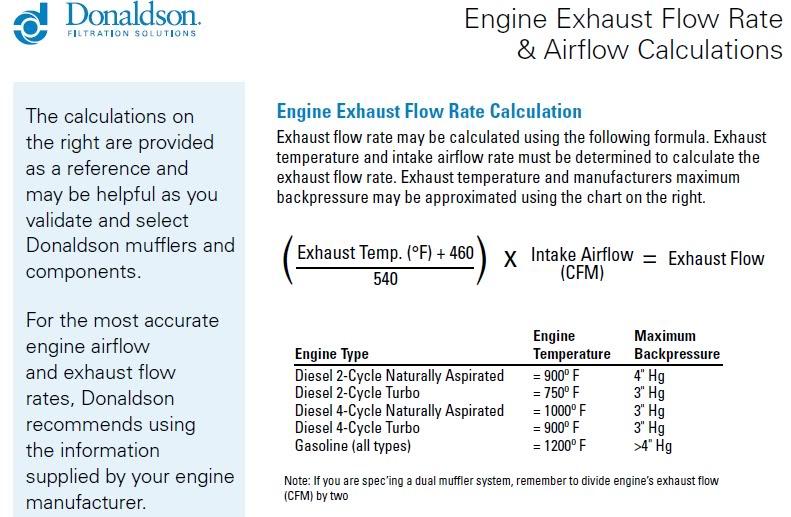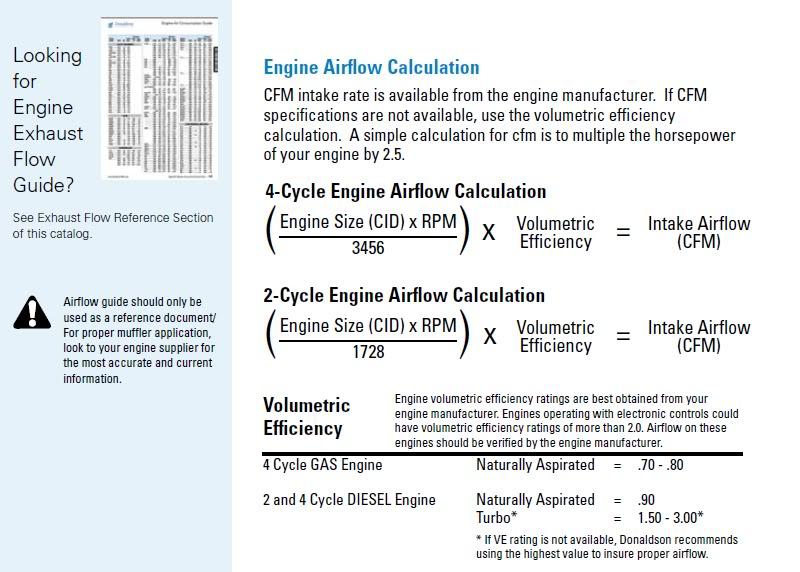OK. I'm getting into some serious pondering about fluid dynamics and ideal exhaust pipe sizes for the TDI. I'd love some input, especially from you engineer types!
It seems there is very little info on exhaust pipe sizes outside V8 headers let alone for diesels. Before you read on, forget everything you relate to petrol exhausts, and realise that the diesel engine flows MUCH greater quantities of gas for a similar hp output to a gasser. The volumetric efficiency of a diesel is much higher than a throttled petrol engine and thus much bigger exhausts are generally recommended.
Now about all I can find anywhere diesel specific is truck information. Donaldson.com has some great info, and below are the screen captures of their CFM calculation for intake and exhaust flows. Using them with max values at 4500rpm, I get about 500CFM intake and towards 1200CFM exhaust! That seems nuts even to me! For sure it's "ideal' has no bends, muffs etc, but I'm after a figure of some sort! If indeed my TDi can flow about 1000CFM at max RPM, what sort of pipe diameter is ideal for Golf length? I'm aware there's too big, just as there is too small.
Basically I'm wondering if the stock GT TDI system at 2.5" for 170hp will be way too small at 250hp plus. Seems likely. I'm thinking 3" which has a much bigger cross section. Again, don't bother telling me what Skylines etc use, I have done a lot of reading in the turbo scene there, but it's a totally different kettle of fish.


Here's the full link for anyone who is interested, but it's a BIG pdf and takes time to download.
http://www.donaldson.com/en/exhaust/...ary/061237.pdf
It seems there is very little info on exhaust pipe sizes outside V8 headers let alone for diesels. Before you read on, forget everything you relate to petrol exhausts, and realise that the diesel engine flows MUCH greater quantities of gas for a similar hp output to a gasser. The volumetric efficiency of a diesel is much higher than a throttled petrol engine and thus much bigger exhausts are generally recommended.
Now about all I can find anywhere diesel specific is truck information. Donaldson.com has some great info, and below are the screen captures of their CFM calculation for intake and exhaust flows. Using them with max values at 4500rpm, I get about 500CFM intake and towards 1200CFM exhaust! That seems nuts even to me! For sure it's "ideal' has no bends, muffs etc, but I'm after a figure of some sort! If indeed my TDi can flow about 1000CFM at max RPM, what sort of pipe diameter is ideal for Golf length? I'm aware there's too big, just as there is too small.
Basically I'm wondering if the stock GT TDI system at 2.5" for 170hp will be way too small at 250hp plus. Seems likely. I'm thinking 3" which has a much bigger cross section. Again, don't bother telling me what Skylines etc use, I have done a lot of reading in the turbo scene there, but it's a totally different kettle of fish.


Here's the full link for anyone who is interested, but it's a BIG pdf and takes time to download.
http://www.donaldson.com/en/exhaust/...ary/061237.pdf



Comment